
Features
Structural
Training
Back to Basics: May 2012
For the past few months, we have been looking at different aspects of ventilation.
April 20, 2012
By Mark van der Feyst
For the past few months, we have been looking at different aspects of ventilation. Most ventilation tasks, with the exception of hydraulic ventilation, fall under truck company operations. Hydraulic ventilation is performed by the engine company as part of its fire-suppression duties, and can be done by by any fire department that conducts interior suppression activities. Hydraulic ventilation is an effective and quick means of ventilating a room. Ventilation is the process of removing smoke and hot gases and replacing them with fresh air. Hydraulic ventilation accomplishes this with just a two-person team operating a hand line.
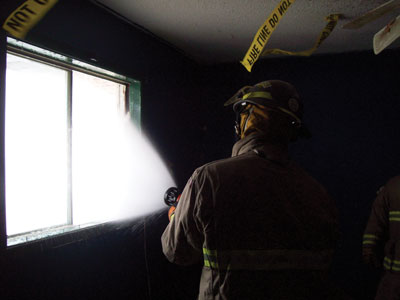 |
|
| Photo 1: Stand about two feet away from a window when performing hydraulic ventilation, but be careful not to block the path of ventilation. | |
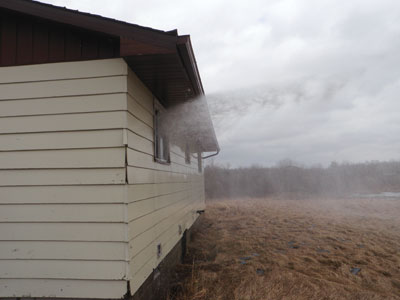 |
|
| Photo 2: Using a fog pattern during hydraulic ventilation helps to expel the byproducts of fire. | |
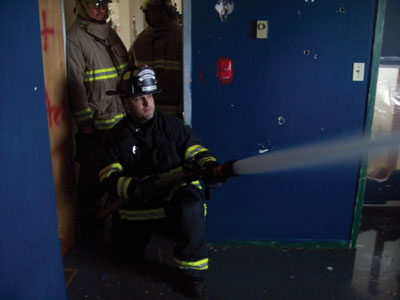 |
|
| Photo 3: A firefighter demonstrates how to ventilate a room from the corner, which offers some thermal protection. | |
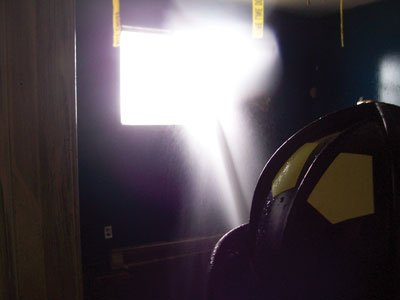 |
|
| Photo 4: When conducting hydraulic ventilation from the back of a room, using a straight stream is optimal both for ventilation and for locating the window. | |
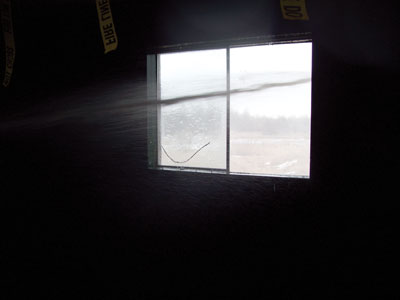 |
|
| Photo 5: A straight stream can accomplish the same effect as a wide fog pattern, as indicated by the direction of the tape on the ceiling. Photos by Mark van der Feyst
|
Whenever a hoseline is used to flow water from a nozzle, air currents are created by the moving water. The air-current volume created is about equal to, if not greater than, the amount of air volume created by a positive-pressure fan. This is a vast amount of air being created by the nozzle, which is used to the advantage of firefighters; the air draws out the smoke and hot gases from a room to the outside of the structure.
Hydraulic ventilation works best in small spaces, such as bedrooms, bathrooms, kitchens and dens. Ventilation of larger areas, such as a great room or open-concept living area, may need assistance from a positive-pressure fan, or from vertical ventilation. Hydraulic ventilation will help in the larger areas, but it may take more time to notice the effects in bigger spaces versus the smaller rooms in which immediate changes are noticeable.
To conduct hydraulic ventilation, an opening to the outside must be used, such as a window or a doorway. Windows are the most common openings in rooms such as bathrooms and bedrooms. The window must be taken out to provide an exit path for the smoke and hot gases. The nozzle must be located within two feet of the window. As you can see in photo 1, the firefighter is standing about two feet back from the window. From this position, the firefighter is ready to flow water from the nozzle in a fog pattern that will cover 85 to 90 per cent of the window opening. This means that the fog pattern should be just touching all four sides of the interior frame of the window. On the outside, the water pattern will carry on expelling all the byproducts of fire, as seen in photo 2.
In photo 1, the firefighter is standing in front of the window, which is not the desired position. It is important to remember that firefighters can block the vent openings by standing in doorways or in front of windows. In this case, the firefighter blocks parts of the ventilation path. Firefighters should be on their knees when conducting this operation. Also, bear in mind that this room just had a fire in it that was suppressed using the nozzle stream, and will be very hot; standing up may not be tolerable.
Notice in photo 1 the caution tape hanging down from the ceiling; this was placed to show the effects of hydraulic ventilation. The air current will pull the caution tape toward the window, if the ventilation is being conducted correctly.
How often do firefighters get within two feet of the window to perform hydraulic ventilation? Most often firefighters are farther back. In photo 3, a firefighter demonstrates how to attack the fire in a room from the doorway. Being at the doorway provides some thermal protection, as firefighters can use the wall to shield themselves from the heat while they apply their water streams. The distance from a doorway to a window will be greater than two feet – usually between eight and 10 feet. Being farther back from the window requires an adjustment to the technique.
As mentioned, moving water creates air currents, similar to those created when using a positive-pressure fan. With a distance greater than two feet from a window and a fog pattern of 85 to 90 per cent of the window opening being maintained, the opposite effect is being created – a positive-pressure fan effect that pushes the smoke and hot gases towards the window area, and eventually back onto firefighters. This happens because of the cone of air that is created by the nozzle and the fog pattern. The farther back from the window the firefighter and nozzle are, the bigger the cone of air becomes. Eventually, the cone of air will reach the window, but it will be larger than the window opening. It will push the smoke and hot gases off the wall beside, above and below the window, and allow them to travel back toward the suppression team.
To prevent this from occurring, the nozzle pattern needs to be changed to a narrow fog, or even a straight stream, from a wide fog. The stream selected to accomplish hydraulic ventilation is almost a straight stream (see photos 4 and 5). The air currents are still being created and will expel the smoke and hot gases. This negates having to adjust the nozzle pattern from a straight stream to a wide fog when trying to ventilate immediately after fire knockdown. This also shows that a smooth-bore nozzle will accomplish the same outcome as an automatic combination nozzle. You can see in photo 5 that the caution tape at the top is being pulled toward the window with an almost straight stream.
Locating the window in the room can also be accomplished by using the nozzle stream. Instead of sending a crew member into the hot environment to locate the window, firefighters can spray water along the wall in a straight stream. The change in the sound of the water bouncing off the wall, and then off the glass, is the indicator that the firefighters have found the window. A good stream of water flowing at the required pressure and flow will break the window from the safety of the doorway. The glass will be hot from the fire and, with cold water being applied, will break even more easily. Another tip is to use the light from the fire to visually locate the window before knocking down the fire.
Mark van der Feyst is a 12-year veteran of the fire service. He currently works for the City of Woodstock Fire Department in Ontario. Mark is an international instructor teaching in Canada, the United States and India. He is a local-level suppression instructor for the Pennsylvania State Fire Academy, an instructor for the Justice Institute of British Columbia and a professor of fire science at Lambton College. E-mail him at Mark@FireStarTraining.com
Print this page